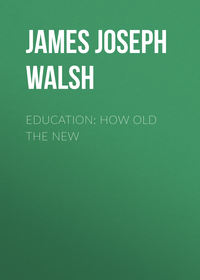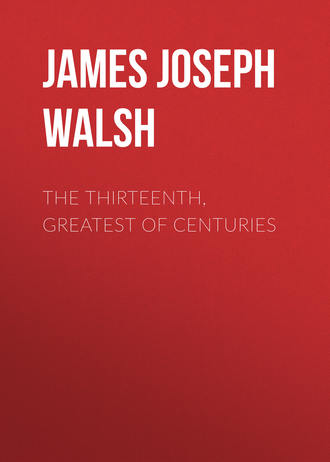 полная версия
полная версияThe Thirteenth, Greatest of Centuries
If we discuss the situation in English-speaking countries as regards the comparative attendance at the universities in the Thirteenth Century and in our own time, we shall be able to get a reasonably good idea of what must be thought in this matter. The authorities are neither difficult of consultation nor distant, and comparatively much more is known about the population of England at this time than about most of the continental countries. England was under a single ruler, while the geographical divisions that we now know by the name of France, Spain, Italy and Germany were the seats of several rulers at least and sometimes of many, a circumstance which does not favor our obtaining an adequate idea of the populations.
That but two universities provided all the opportunities for whatever higher education there was in England at this time, would of itself seem to stamp the era as backward in educational matters. A little consideration of the comparative number of students with reference to the population of the country who were thus given the opportunity for higher education—and took advantage of it—at that time and the present, will show the unreasonableness of such an opinion. It is not so easy as might be imagined to determine just what was the population even of England in the Thirteenth Century. During Elizabeth's reign there were, according to the census, an estimate made about the time of the great Armada, altogether some four millions of people. Froude, accepts this estimate as representing very well the actual number of the population. Certainly there were not more than five millions at the end of the Sixteenth Century. Lingard, who for this purpose must be considered as a thoroughly conservative authority, estimates that there were not much more than two millions of people in England at the end of the Twelfth Century. This is probably not an underestimate. At the end of the Thirteenth Century there were not many more than two millions and a half of people in the country. At the very outside there were, let us say, three millions. Out of this meagre population, ten thousand students were, on the most conservative estimate, taking advantage of the opportunities for the higher education that were provided for them at the universities.
At the present moment, though we pride ourselves on the numbers in attendance at our universities, and though the world's population is so much more numerous and the means of transportation so much more easy, we have very few universities as large as these of the Thirteenth Century. No American university at the present moment has as large a number of students as had Oxford at the end of the Thirteenth Century, and of course none of them compares at all with Paris or Bologna in this respect. Even the European universities, as we have suggested, fall behind their former glory from this standpoint. In the attendance to the number of population the comparison is even more startling for those who have not thought at all of the Middle Ages as a time of wonderful educational facilities and opportunities. In the greater City of New York as we begin the Twentieth Century there are perhaps fifteen thousand students in attendance at educational institutions which have university privileges. I may say that this is a very liberal allowance. At universities in the ordinary sense of the word there are not more than ten thousand students and the remainder is added in order surely to include all those who may be considered as doing undergraduate work in colleges and schools of various kinds. Of these fifteen thousand at least one-fourth come from outside of the greater city, and there are some who think that even one-third would not be too large a number to calculate as not being drawn directly from our own population. Connecticut and New Jersey furnish large numbers of students and then, besides, the post-graduate schools of the universities have very large numbers in attendance even from distant states and foreign countries.
It will be within the bounds of truth, then, to say, that there are between ten and twelve thousand students, out of our population of more than four millions in Greater New York taking advantage of the opportunities for the higher education provided by our universities and colleges. At the end of the Thirteenth Century in England there were at least ten thousand students out of a population of not more and very probably less than three millions, who were glad to avail themselves of similar opportunities. This seems to be perfectly fair comparison and we have tried to be as conservative as possible in every way in order to bring out the truth in the matter.
It can scarcely fail to be a matter of supreme surprise to find that a century so distant as the Thirteenth, should thus equal our own vaunted Twentieth Century in the matter of opportunities for the higher education afforded and taken advantage of. It has always been presumed that the Middle Ages, while a little better than the Dark Ages, were typical periods in which there was little, if any desire for higher education and even fewer opportunities. It was thought that there was constant repression of the desire for knowledge which springs so eternally in the human heart and that the Church, or at least the ecclesiastical authorities of the time, set themselves firmly against widespread education, because it would set people to thinking for themselves. As a matter of fact, however, every Cathedral and every monastery became a center of educational influence, and even the poorest, who showed special signs of talent, obtained the opportunity to secure knowledge to the degree that they wished. It is beyond doubt or cavil, that at no time in the world's history have so many opportunities for the higher education been open to all classes as during the Thirteenth Century.
In order to show how thoroughly conservative are the numbers in attendance at the universities that I have taken, I shall quote two good recent authorities, one of them Professor Laurie, the Professor of the Institutes and History of Education in the University of Edinburgh, and the other Thomas Davidson, a well-known American authority on educational subjects. Each of their works from which I shall quote has been published or revised within the last few years. Professor Laurie in "The Rise and Early Constitution of the University with a Survey of the Medieval Education," which formed one of the International Educational Series, edited by Commissioner Harris and published by Appleton, said:
"When one hears of the large number of students who attended the earliest universities—ten thousand and even twenty thousand at Bologna, an equal, and at one time a greater, number at Paris, and thirty thousand at Oxford—one cannot help thinking that the numbers have been exaggerated. There is certainly evidence that the Oxford attendance was never so great as has been alleged (see Anstey's 'Mon Acad.'); but when we consider that attendants, servitors, college cooks, etc., were regarded as members of the university community, and that the universities provided for a time the sole recognized training grounds for those wishing to enter the ecclesiastical or legal or teaching professions, I see no reason to doubt the substantial accuracy of the tradition as to attendance—especially when we remember that at Paris and Oxford a large number were mere boys of from twelve to fifteen years of age."
As to the inclusion of servitors, we have already said that many, probably, indeed, most of them, were actual students working their way through the university in these enthusiastic days. Professor Laurie's authority for the assertion that a large number of the students at Paris and Oxford were mere boys, is a regulation known to have existed at one of these universities requiring that students should not be less than twelve years of age. Anyone who has studied medieval university life, however, will have been impressed with the idea, that the students were on the average older at the medieval universities rather than younger than they are at the present time. The rough hazing methods employed, almost equal to those of our own day! would seem to indicate this. Besides, as Professor Laurie confesses in the next paragraph, many of the students were actually much older than at present. Our university courses are arranged for young men between 17 and 22, but that is, to fall back on Herbert Spencer, presumably because the period of infancy is lengthening with the evolution of the race. There are many who consider that at the present time students are too long delayed in the opportunity to get at the professional studies, and that it is partly the consequence of this that the practical branches are so much more taken up under the elective system. As we said in the chapter on Universities and Preparatory Schools, in Italy and in other southern countries, it is not a surprising thing to have a young man graduate at the age of 16 or 17 with his degree of A. B., after a thoroughly creditable scholastic career. This means that he began his university work proper under 13 years of age; so that we must judge the medieval universities to some extent at least with this thought in mind.
Mr. Thomas Davidson in his "History of Education,"7 in the chapter on The Medieval University has a paragraph in which he discusses the attendance, especially during the Thirteenth Century, and admits that the numbers, while perhaps not so large as have been reported, were very large in comparison to modern institutions of the same kind, and frankly concedes that education rose during these centuries which are often supposed to have been so unfavorable to educational development, to an amazing height scarcely ever surpassed. He says:
"The number of students reported as having attended some of the universities in those early days almost passes belief; e. g. Oxford is said to have had thirty thousand about the year 1300, and half that number even as early as 1224. The numbers attending the University of Paris were still greater. These numbers become less surprising when we remember with what poor accommodations—a bare room and an armful of straw—the students of those days were content, and what numbers of them even a single teacher like Abelard could, long before draw into lonely retreats. That in the Twelfth and following centuries there was no lack of enthusiasm for study, notwithstanding the troubled condition of the times, is very clear. The instruction given at the universities, moreover, reacted upon the lower schools, raising their standard and supplying them with competent teachers. Thus, in the Thirteenth and Fourteenth centuries, education rose in many European states to a height which it had not attained since the days of Seneca and Quintilian."
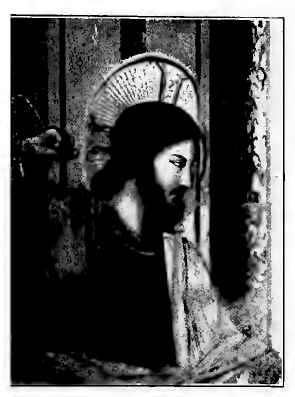
CHRIST DRIVING OUT MONEY CHANGERS (GIOTTO)
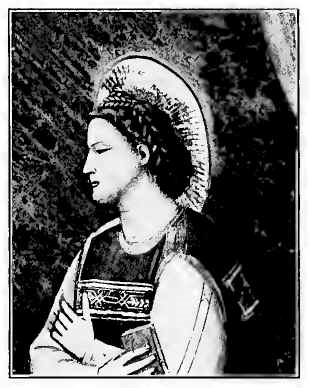
HEAD FROM ANNUNCIATION (GIOTTO)
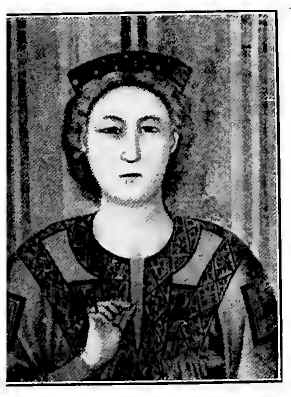
BRIDE MARRIAGE AT CANA (GIOTTO)
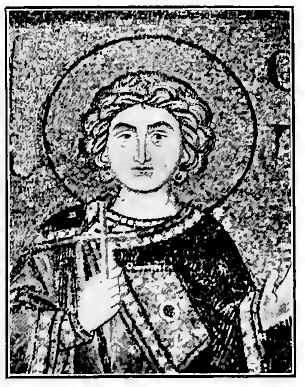
SAINT'S HEAD (MOSAIC, ST. MARK'S VENICE)
A very serious objection that would seem to have so much weight as to preclude all possibility of accepting as true the large numbers mentioned, is the fact that it is very hard to understand how such an immense number of students could have been supported in any town of the Middle Ages. This objection has carried so much weight to some minds as to make them give up the thought of large numbers at the medieval universities. Professor Laurie has answered it very effectively, however, and in his plausible explanation gives a number of points which emphasize the intense ardor of these students of the Middle Ages in their search for knowledge, and shows how ready they were to bear serious trials and inconveniences, not to say absolute sufferings and hardships, in order that they might have opportunities for the higher education. The objection then redounds rather to the glory of the medieval universities than lessens their prestige, either as regards numbers or the enthusiasm of their students.
"The chief objection to accepting the tradition (of large numbers at the universities) lies in the difficulty of seeing how in those days, so large a number of the young men of Europe could afford the expense of residence away from their homes. This difficulty, however, is partly removed when we know that many of the students were well to do, that a considerable number were matured men, already monks and canons, and that the endowments of Cathedral schools also were frequently used to enable promising scholars to attend foreign universities. Monasteries also regularly sent boys of thirteen and fourteen to university seats. A papal instruction of 1335 required every Benedictine and Augustinian community to send boys to the universities in the proportion of one in twenty of their residents. Then, state authorities ordered free passages for all who were wending their way through the country to and from the seat of learning. In the houses of country priests—not to speak of the monastery hospitals—traveling scholars were always accommodated gratuitously, and even local subscriptions were frequently made to help them on their way. Poor traveling scholars were, in fact, a medieval institution, and it was considered no disgrace for a student to beg and receive alms for his support."
After reading these authoritative opinions, it would be rather difficult to understand the false impressions which have obtained so commonly for the last three centuries with regard to education in the Middle Ages, if we did not realize that history, especially for English-speaking people, has for several centuries been written from a very narrow standpoint and with a very definite purpose. About a century ago the Comte de Maistre said in his Soirées de St. Petersburg, that history for the three hundred years before his time "had been a conspiracy against the truth." Curiously enough the editors of the Cambridge Modern History in their first volume on the Renaissance, re-echoed this sentiment of the French historical writer and philosopher. They even use the very words "history has been a conspiracy against the truth" and proclaim that if we are to get at truth in this generation, we must go behind all the classical historians, and look up contemporary documents and evidence and authorities once more for ourselves. It is the maintenance of a tradition that nothing good could possibly have come out of the Nazareth of the times before the Reformation, that has led to this serious misapprehension of the true position of those extremely important centuries in modern education—the Thirteenth and the Fourteenth.
To those who know even a little of what was accomplished in these centuries, it is supremely amusing to read the childish treatment accorded them and the trivial remarks that even accredited historians of education make with regard to them. Occasionally, however, the feeling of the reader who knows something of the subject is not one of amusement, but far from it. There are times when one cannot help but feel that it is not ignorance, but a deliberate purpose to minimize the importance of these times in culture and education, that is at the basis of some of the utterly mistaken remarks that are made. We shall take occasion only to give one example of this, but that will afford ample evidence of the intolerant spirit that characterizes the work of some even of the supposedly most enlightened historians of education. The quotation will be from Compayré's "History of Pedagogy" which is, I understand, in use in nearly every Normal School in this country and is among the books required in many Normal School examinations.
M. Compayré in an infamous paragraph which bears the title "The Intellectual Feebleness of the Middle Age," furnishes an excellent example of how utterly misunderstood, if not deliberately misrepresented, has been the whole spirit and content and the real progressiveness of education in this wonderful period. After some belittling expressions as to the influence of Christianity on education—expressions utterly unjustified by the facts—he has this to say with regard to the Thirteenth Century, which is all the more surprising because it is the only place where he calls any attention to it. He says:
"In 1291, of all the monks in the convent of St. Gall, there was not one who could read and write. It was so difficult to find notaries public, that acts had to be passed verbally. The barons took pride in their ignorance. Even after the efforts of the Twelfth Century, instruction remained a luxury for the common people; it was the privilege of the ecclesiastics and even they did not carry it very far. The Benedictines confess that the mathematics were studied only for the purpose of calculating the date of Easter."
This whole paragraph of M. Compayré (the rest must be read to be appreciated), whose history of education was considered to be of such value that it was deemed worthy of translation by the President of a State Normal School and that it has been adopted as a work of reference, in some cases of required study, in many of the Normal Schools throughout the country, is a most wonderful concoction of ingredients, all of which are meant to dissolve every possible idea that people might have of the existence of any tincture of education during the Middle Ages. There is only one fact which deeply concerns us because it refers to the Thirteenth Century. M. Compayré says that in 1291 of all the monks of the Convent of Saint Gall there was not one who could read and write. This single fact is meant to sum up the education of the century for the reader. Especially it is meant to show the student of pedagogy how deeply sunk in ignorance were the monks and all the ecclesiastics of this period.
Before attempting to say anything further it may be as well to call attention to the fact that in the original French edition the writer did not say that there was not a single monk. He said, "There was but one monk, who could read and write." Possibly it seemed to the translator to make the story more complete to leave out this one poor monk and perhaps one monk more or less, especially a medieval monk, may not count for very much to modern students of education. There are those of us, however, who consider it too bad to obliterate even a single monk in this crude way and we ask that he shall be put back. There was one who could read and write and carry on the affairs of the monastery. Let us have him at least, by all means.
In the year 1291 when M. Compayré says that there was but a single monk at the monastery of St. Gall who could read and write, he, a professor himself at a French Normal School, must have known very well that there were over twenty thousand students at the University of Paris, almost as many at the University of Bologna, and over five thousand, some authorities say many more than this (Professor Laurie would admit more than ten thousand), at the University of Oxford, though all Christian Europe at this time did not have a population of more than 15,000,000 people. He must have known, too, or be hopelessly ignorant in educational matters, that many of the students at these universities belonged to the Franciscans and Dominicans, and that indeed many of the greatest teachers at the universities were members of these monastic orders. Of this he says nothing, however. All that he says is "Education was the privilege of the ecclesiastics and they did not carry it very far." This is one way of writing a history of education. It is a very effective way of poisoning the wells of information and securing the persistence of the tradition that there was no education until after the beginning of the Sixteenth Century.
Meantime one can scarcely help but admire the ingenuity of deliberate purpose that uses the condition of the monastery of St. Gall to confirm his statement. St. Gall had been founded by Irish monks probably about the beginning of the Eighth Century. It had been for at least three centuries a center of education, civilization and culture, as well as of religion, for the barbarians who had settled in the Swiss country after the trans-migration of nations. The Irish had originally obtained their culture from Christian Missionaries, and now as Christian Missionaries they brought it back to Europe and accomplished their work with wonderful effectiveness. St. Gall was for centuries a lasting monument to their efforts. After the Tenth Century, however, the monastery began to degenerate. It was almost directly in the path of armies which so frequently went down to Italy because of the German interest in the Italian peninsula and the claims of the German emperor. After a time according to tradition, the emperor insisted that certain of the veterans of his army should be received and cared for in their old age at St. Gall. Gradually this feature of the institution became more and more prominent until in the Thirteenth Century it had become little more than a home for old soldiers. In order to live on the benefices of the monastery these men had to submit to ecclesiastical regulations and wear the habit. They were, it is true, a sort of monk, that is, they were willing, for the sake of the peace and ease which it brought, to accept the living thus provided for them and obey to some degree at least the rules of the monastery. It is not surprising that among these there should have been only one who could read and write. The soldiers of the time despised the men of letters and prided themselves on not being able to write. That a historian of pedagogy, however, should take this one fact in order to give students an idea of the depth of ignorance of the Middle Ages, is an exhibition of some qualities in our modern educated men, that one does not like to think of as compatible with the capacity to read and write. It would indeed be better not to be able to read and write than thus to read and write one's own prejudices into history, and above all the history of education.
Compayré's discussion of the "Causes of the Ignorance" of the Middle Ages in the next paragraph, is one of the most curious bits of special pleading by a man who holds a brief for one side of the question, that I think has ever been seen in what was to be considered serious history. He first makes it clear how much opposed the Christian Church was to education, then he admits that she did some things which cannot be denied, but minimizes their significance. Then he concludes that it was not the fault of the Church, but in this there is a precious bit of damning by faint praise. It would be impossible for any ordinary person who had only Compayré for authority to feel anything after reading the paragraph, but that Christianity was a serious detriment and surely not a help to the cause of progress in education. I quote part of the paragraph:
"What were the permanent causes of that situation which lasted for ten centuries? The Catholic Church has sometimes been held responsible for this. Doubtless the Christian doctors did not always profess a very warm sympathy for intellectual culture. Saint Augustine has said: It is the ignorant who gain possession of heaven (indocti coelum rapiunt.) Saint Gregory the Great, a Pope of the Sixth Century, declared that he would blush to have the holy word conform to the rules of grammar. Too many Christians, in a word, confounded ignorance with holiness. Doubtless, towards the Seventh Century, the darkness still hung thick over the Christian Church. Barbarians invaded the Episcopate, and carried with them their rude manners. Doubtless, also, during the feudal period the priest often became a soldier, and remained ignorant. It would, however, be unjust to bring a constructive charge against the Church of the Middle Age, and to represent it as systematically hostile to instruction. Directly to the contrary, it is the clergy who, in the midst of the general barbarism, preserved some vestiges of the ancient culture. The only schools of that period are the Episcopal and claustral schools, the first annexed to the Bishops' palaces, the second to the monasteries. The religious orders voluntarily associated manual labor with mental labor. As far back as 530, St. Benedict founded the Convent of Monte Cassino, and drew up statutes which made reading and intellectual labor a part of the daily life of the monks." When this damning by faint praise is taken in connection with the paragraph in which only a single monk at the Monastery of St. Gall is declared to have been able to read and write, the utterly false impression that is sure to result, can be readily understood even by those who are not sympathetic students of the Middle Ages. This is how our histories of education have been written as a rule, and as a consequence the most precious period in modern education, its great origin, has been ignored even by professional scholars, to the great detriment not only of historical knowledge but also of any proper appreciation of the evolution of education.






